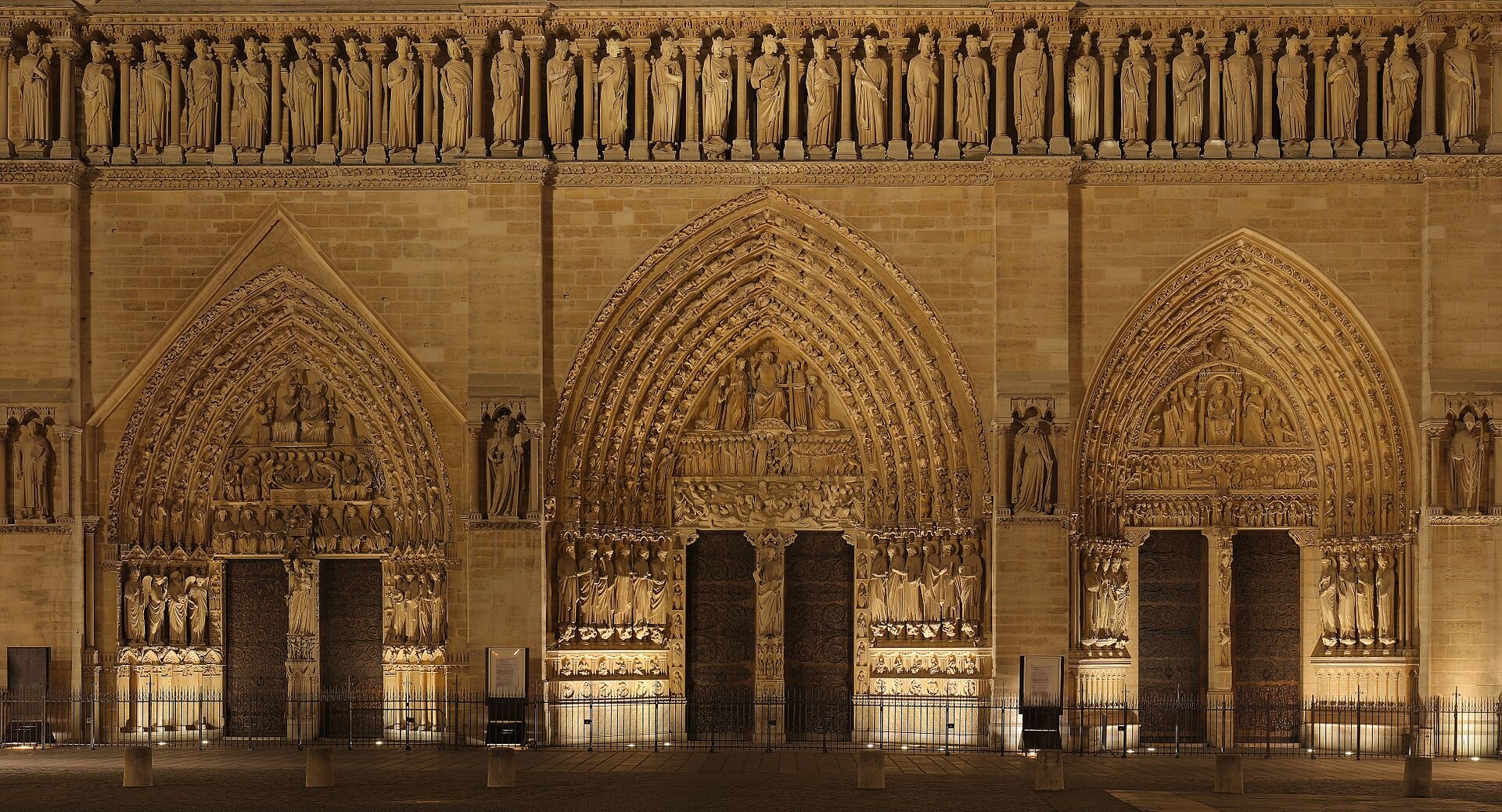1



















| Thumbs Up |
| Received: 34,729 Given: 61,129 |

Notre Dame: Lessons to Learn
Some readers may be familiar with the late sixties BBC television series “Civilisation”. Standing before a majestic Notre Dame Cathedral in Paris, Kenneth Clark opens the series saying; “What is Civilisation? I don’t know. I can’t define it in abstract terms, yet. But I think that I can recognise it when I see it, and I’m looking at it now”.
Many, myself included, reacted with disbelief at the news that, in suspicious circumstances, flames had begun to engulf Notre Dame Cathedral. Then our shock was replaced with tears as we saw, thanks to modern news and social media, in real time, the destruction unfold and the gasps of horror from Parisians as the Gothic spire collapsed, succumbing to the unholy inferno.
Indeed it is an equal sadness to learn that for the first time since the French Revolution, there was to be no Christmas Mass at Notre Dame. In moments like this we suddenly realise that Notre Dame is not just a museum of 13th Century technological ingenuity but rather a building built with a very specific motivation and for a specific purpose.
Notre Dame is a symbol as much as a building. It’s a symbol of Paris, of France and of Christendom. It represents a past that is by no means gone, but lives on in the stone of a living structure, a living Church. A Church that both as a building and as a divine Institution is wounded but resilient.
To examine the reasons for restoring Notre Dame we must first examine the reasons why our ancestors built it in the first place. Cathedrals aren’t built by individuals but by communities, and not by one generation but many. On a human level it’s a legacy passed down to us from the past. On a supernatural level it’s an act of devotion, done for the glory of God. A statement of priorities, investing such an effort to build something worthy of offering the Holy Sacrifice of the Mass.
Such a building is not for us (much less the French state) to own, but rather to have stewardship over. It is our duty to care for it and pass it down in good condition to the next generation. In this we have certainly blundered and with talk of “modernising” and redesigning the architectural marvel to be more “inclusive” we aren’t that far away from total failure.
Not many know that in France since the 1905 law on the Separation of Church and State, the State claims legal ownership over all historic church buildings, and thus is responsible for their upkeep. After decades of underinvestment from the French authorities (which no doubt exacerbated and contributed to the destruction) and an ongoing campaign of vandalism and arson targeting Catholic churches, led by anarchists and others, it is easy to despair over the future public visibility of the faith in France.
Yet in the depths of darkness a light shone. Young Catholics sent a message to heaven and earth. Gathering by the banks of the Seine, they raised up a mournful hymn of the Hail Marys. Many think of France, and in particular Paris, as a deeply secularised society, yet under this outward skin of secularism lies a beating Catholic heart. Young Catholics (practicing and others no doubt further away from the Church), paralyzed with shock, not knowing what to do, utterly helpless to halt the ever growing flames, simply defaulted to prayer and appropriately invoked the guidance of the patron of this great Cathedral, Our Lady of Paris.
Thankfully due to the heroism of the Paris fire brigade and in particular of Fr Jean-Marc Fournier, the Blessed Sacrament and the relics (most notable the Crown of Thorns) were rescued from the fire. Paris has had to contend with a series of recent tragedies and Fr Fournier has been at the frontline of many. It was also he, in his role as chaplain to the fire brigade, who was one of the first responders to the November 2015 Islamic State attacks in Paris, that killed over 130 innocent people, administering the last rites to the dying.
Architecture is different to other forms of art. A painting is private. One can choose to look at it or not. Architecture, however, is by its nature public. To discover what a society believes, we look at what buildings or structures are given the most prominence. In Vienna the answer is undoubtedly St Stephen's Cathedral. In Rome it’s St. Peter’s Basilica. In Venice it’s St Mark's Basilica. In New York it's the Empire State building, for London it’s the House of Commons and unfortunately for Dublin it's the Ha'penny Bridge. When one thinks of Paris, what first springs to mind is Notre Dame, the Eiffel Tower and the Arc de Triomphe.
Landmark buildings in this way are a depository of civilisation, a symbol that transcends the individual or the nation. They were not built as a tourist attractions, but rather to be a beating heart of the community. St Stephen's Cathedral in Austria and York Cathedral in England much like Notre Dame suffered similar fates in their recent history and rose up once more. St Stephens was burnt to ashes (with only the stone structure surviving) in the wake of the Soviet Russian assault on the city during the Second World War. York Cathedral suffered a similar fire when hit by a lightning strike in 1984.
Today these gothic cathedrals have been restored to their former glory and resume their timeless functions. The restoration of Vienna particularly was a major project on the scale of Notre Dame and united the nation of Austria in a time of searching and despair. Lessons can be learnt from the restoration process of both, which could benefit Notre Dame.
For example York Cathedral introduced fire resistant plaster, a compartmentalised roof structure and a centralized fire detection system. Together these measures dramatically improve the possibility to contain any future fire.
The damage in York was not as widespread as Vienna. The stained glass suffered only heat damage from the fire and not the additional explosive blast damage that the windows in St Stephan’s faced. Glass is thankfully very resistant to heat. The sainted glass in Notre Dame was preserved quite well to the surprise of many. However, as with York Cathedral, upon closer inspection it is possible to see micro-damage to the glass that makes it susceptible to wind damage from storms, and will thus require restoration work.
Another consideration of course is time. Notre Dame was constructed step by step over dozens of generations, not a handful of years. Yet the French government sees it as a personal project to have the cathedral reopened in time for the 2024 Summer Olympics. This is a particular modern phenomenon. We have lost a sense of patience and emboldened by our access to modern technology, we think only of how quick and how cheap something can be built and not more importantly, how well. The root of this problem is a lack of clarity on why we build. Only when we have a supernatural outlook can we hope to hope to restore Notre Dame, handing it down in turn to future generations.
When it comes to buildings like Cathedrals, whether we articulate it or not, we praise continuity much more than novelty. If one wishes to see novelty they need only look around them. However, one must and does indeed, seek out continuity. It certainly would be novel to turn Notre Dame into a multi-story carpark. Such a redesign would solve the ongoing city centre parking shortage and as many modern artists say, would “subvert our expectations”. However, then it would cease to be Notre Dame and would be merely just like anywhere else. What many modern architects fail to realise is that in a world of hyper-novelty, continuity is the greatest novelty of all.
So when French prime minister Édouard Philippe announced a redesign competition saying that he hoped to give Notre Dame “a spire adapted to techniques and challenges of our time”, as well you could imagine, many feared the worst. Redesign proposals for a secular museum of France, for botanic gardens and for glass roofs are merely expressions of the arrogance of our own generation. We shun our past and foolishly refer to the Medieval Ages as the “Dark Ages”. A refusal to listen, to learn from a whispering giant like Notre Dame is a failure to listen to our forefathers.
Thankfully wisdom thus far has appeared to prevail. July of last year, the French parliament after much heated debate (a debate emblematic of the differing vision of the purpose and nature of beauty), decided to restore the great wonder to it’s pre-fire condition, as best as possible to the original design. We can therefore hope and pray that future generations too will one day soon enjoy Notre Dame as so many have before.
Niall Buckley
January 2019

Image of Notre Dame by Benh Lieu Song
Wake up and smell the coffee.














| Thumbs Up |
| Received: 4,996 Given: 10,531 |

former england footballer peter beardsley will be glad to have his home restored soon enough















| Thumbs Up |
| Received: 4,996 Given: 10,531 |

former england footballer peter beardsley will be glad to have his home restored soon enough

There are currently 1 users browsing this thread. (0 members and 1 guests)
 France
France
 Canada
Canada
Bookmarks